The Polish Navy
Cliquez ici pour la version francaise
During the inter-war years the Polish navy had suffered through poor resourcing as the army and fledgling air force formed a greater role in defence strategies. 'Poland had a million men under arms, including twelve brigades of cavalry; on paper it was an impressive force, all the more impressive in the eyes of those fatally romantic Polish generals who were convinced that with bravery and enough horses once could do anything' (Budiansky, 2000: 69). However, while this may re-enforce popular myths about the state of Polandís armed forces (Polskie Sily Zbrojne or PSZ), Poland had since reorganization in 1926 been practicing war games for the coming conflict. The strategic planning simulated invasions from the Germany (Plan N) or from Soviet invasion (Plan R). The Poles even simulated a two front invasion (Plan N + R) (Zaloga and Madej, 1991). The navy had been earmarked in a lesser role, albeit important in protecting the ports and merchant fleet in the Baltic waters. Formed on the 28th November 1928 (to celebrate the victory of Oliwa), Jozef Pilsudski had been impressed by the strategic treatise of Marian Kadulski who envisaged the absolute control of the Baltic Sea being governed by a fleet of fast motor torpedo boats and mine laying submarines (Peszke, 1999). Hopes of creating a navy through war reparations had been dashed when the German fleet was scuttled in Scapa Flow in the Orkneys, Scotland on 21st June 1919.
In the early 1920s Section II (Biuro Szfrow) of the Army General Staff had been regularly breaking and listening into German communications traffic. 'In February 1926 German Navy messages became unreadable; in July 1928 the Army messages followed suit' (Budiansky, 2000: 69). Machine generated ciphers were suspected and while early models of the Enigma machine had been exhibited in a Swiss business exhibition in 1928, Polish Intelligence were keen not only to crack German codes, but also be able to replicate the machine (Stafford, 2000). By 1928 Poland had been secretly reading German traffic and this was the "ace up the sleeve" as both Britain and France could not and were in effect blind to German communications.
Expenditure on the navy represented about 2% of the national defence budget (Zaloga and Madej, 1991) and whose strategic role would be to deny easy access to the key ports. The navy was relatively small and equiped with modern ships of which much pride was attached. Polish shipyards had started too late to be geared up for construction and this held back a greater role. The table below indicates the size and status of each class of ship.
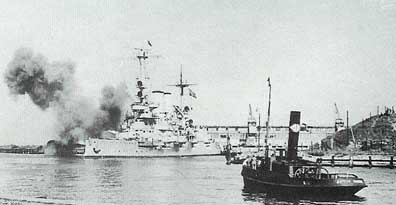
Schleswig-Holstein shelling Westerplatte garrison September 1939
The Polish Navy
|
Class/Type
|
Simoun
Destroyer
|
Grom
Destroyer
|
Gryf
Minelayer
|
Rys
Submarine
|
Orzel
Submarine
|
Jaskolka
Minesweeper
|
|
Displacement
|
1920
|
2144
|
2250
|
980/1250
|
1100/1650
|
183
|
|
Length (m)
|
107
|
114
|
103
|
78
|
84
|
45
|
|
Main guns
|
4-130mm
|
7-120mm
|
6-120mm
|
1-100mm
|
1-105mm
|
1-75
|
|
AA Guns
|
2-40mm
|
4-40mm
|
4-40mm
|
|
2-40mm
|
|
|
AA MG's
|
4-13mm
|
2-13mm
|
8-13mm
|
2-13mm
|
1-13mm
|
13mm/7.62mm
|
550mm
Torpedo tube
|
2 triple
|
2 triple
|
|
6
|
12
|
|
Max speed
Knt
|
33
|
39
|
20
|
14/9
|
19/9
|
18
|
|
Crew
|
155
|
190
|
205
|
54
|
62
|
30
|
Country of
builder
|
France
|
Britain
|
France
|
France
|
Netherlands
|
Poland
|
|
No. in Class
|
2
|
2
|
1
|
3
|
2
|
6
|
|
Action
|
Wicher: Destroyed Sept. 1939.
Burza: with Grom and Blyskawica left Gdynia on 1st September 1939 and sailed to Leith in Scotland. Returned to Poland 1947 and is now a museum ship.
|
Grom: sunk 4th May 1940 after the Battle of Narvik in Rombaks fjord, Norway.
Blyskawica: With Grom left Gdynia on 1st September 1939 and sailed to Leith in Scotland. Originally based at Harwich saw action in Norway, convoy escort in Western Approaches, Mediterranean and Home fleet/ operations
|
Gryf: Destroyed Sept. 1939
|
Rys and Zbik Interned in Sweden.
Wilk: escaped to England.
|
Sep: Interned in Sweden.
Orzel: Escaped to Estonia and interned in Tallinn, escaped and made it to Rosyth, Scotland Oct 1939. Sank German troop carrier (Rio de Janeiro) off Norway 8th April 1940. Action in the Baltic and North Sea.
|
|
Based on: Zaloga and Madej (1991)
Poland's mobilization order for ground units was made on 26th August 1939 followed by the general mobilization order on 30th August 1939, was not done to force the hand of Britain and France, but on the need to respond the German battle orders. On 28th August 1939 all Polish flag carriers were ordered to remain outside the Baltic Sea with the Polish Destroyer Division ordered to sail for Britain on 30th August 1939 (Peszke, 2005) under operation PeKing in an agreement with Britain's admiralty. When war broke out on 1st September 1939 some of Polish Navy had successfully run the gauntlet while others heroically defended the approaches to the ports and Westerplatte. The old German battleship Schleswig-Holstein entered Danzig on an official visit before formal declaration of war had been made. It shelled the Westerplatte garrison at 04.45 from an advantageous position within the main port.
Coastal Defences:
The Seacoast Defence Force and units of the Polish Navy defended the Baltic Coast. Split into four operational areas KOP battalion defended the Hel Peninsula under the command of Wlodimierz Steyer and consisted of 2,800 troops attached to AA units and shore batteries (Zaloga and Madej, 1991). These units were quickly isolated in the first few hours of the invasion. The Hel Peninsula was bypassed until the Wehrmacht objectives of capturing and securing the ports at Gdynia and Gdansk were secured.
The Naval Rifle Brigade and the Naval National Guard Brigade under the command Col. Stanislaw Dabek consisted of approximately 14,00 troops forming a defensive perimeter around the Oskswie Bay in which lay the naval ports of Gdynia and Gdansk. A complex network of shore batteries and AA positions ringed the bay and Zaloga and Madej (1991) indicate troops were supplemented with local militias.
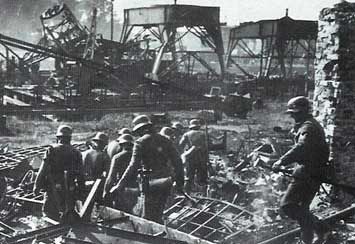 SS Heimwehr Danzig battalion supported by Wehrmacht regulars and Pionier Lehrbataillon attacking Gdansk.
SS Heimwehr Danzig battalion supported by Wehrmacht regulars and Pionier Lehrbataillon attacking Gdansk.
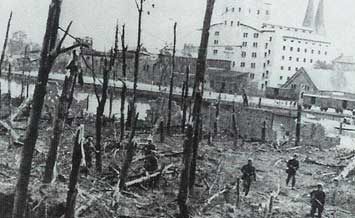 The remains of the Westerplatte Garrison
The remains of the Westerplatte Garrison
The Westerplatte garrison were the first units to be engaged in the sea and land borne warfare with SS Heimwehr Danzig supported by Wehrmacht regular troops and police units attacking the maze of concealed units overlooking the sea dubbed 'little Verdun' and exacted high casualties on the Germans including 300 dead before the garrison fell on 7th September 1939 (Zaloga and Madej, 1991; Peszke, 2000).
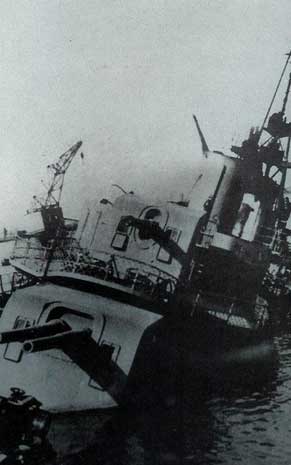 ORP Gryf
ORP Gryf
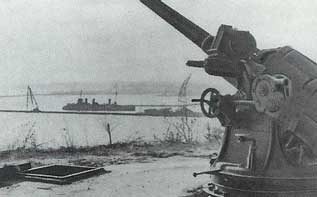 Coastal battery at Oksywie
Coastal battery at Oksywie
At Oksywie the German 207th Infantry Division supported by various paramilitary units and made up a force of about 26,000 troops attacked a much smaller and poorly equiped Polish force. Kartuzy was over-run on 4th September and the Polish forces retreated towards the main ports. The Hel Peninsula garrison had sustained constant bombardment and once the main ports had fallen, both the Luftwaffe and the Schleswig-Holstein pounded the base. Despite days of constant bombardment, the garrison regularly repulsed attacks with hand-to-hand fighting. Pushed back to Kuznica, the Poles detonated massive mines and temporarily separated the peninsula from the mainland in an attempt to stem the attacks. Admiral Jozef Unreg, commander of the garrison decided to continue fighting despite the fall of Warsaw on 29th September and continued a dogged fight until 1st October 1939 when the ceasefire took effect in the early afternoon.
The small and dedicated navy put up stiff resistance to the invasion with numerous acts of gallantry against all odds. ORP Mazur surrendered only when the gunners on the sinking vessel were waist deep in water and unable to operate the gun. While Burza, Grom and Blyskawica had escaped to Leith in Scotland, the remaining fleet fought with some success although limited. Gryf and Wicher set fire and destroyed the German flagship Leberecht Maas on 3rd September before a mass German bomber strike sank them. The submarine fleet escaped and either faced internship in Sweden or as in the case of Wilk escaped to Britain while Orzal under the command of captain Jan Grudzinski heroically escaped from Tallinn in Estonia with no charts, munitions or gun locks to Rosyth naval base in Scotland, home to Britainís submarine fleet.
In other actions the German minesweeper M-85 was sunk by mines laid by ORP Zbik while the destroyers Burza and Blyskawica had attacked and most likely destroyed U-boat before leaving the Baltic.
Britain
On 18th September 1939 the Polish Navy became attached to the Royal Navy under British Admiralty command and were assigned a number of destroyers under a lease scheme. The Polish navy consisted of six destroyers (Garland, Piorun, Krakowiak, Kujawiak, Slazak, Orkan), 3 submarines (SokÛl, Jastrab and Dzik) six motor torpedo boats and two cruisers (Dragon and Conrad). Their theatre of operations ranged from convoy protection in the Atlantic and Mediterranean, action in the North Sea or special tasks defending special operations, for example, Blyskawica provided cover for troop withdrawal from the beaches of Dunkirk. Both Blyskawica and Grom were in action during the Norwegian Campaign at Narvik engaging German coastal batteries where Grom was sunk in the Rombaken fjord. At night on 20th June 1940 Wilk detected a U-boat and rammed it. In a true 'David and Goliath' engagement the ORP destroyer Piorun detected and engaged the mighty battle-ship Bismarck winning respect for their gallantry.
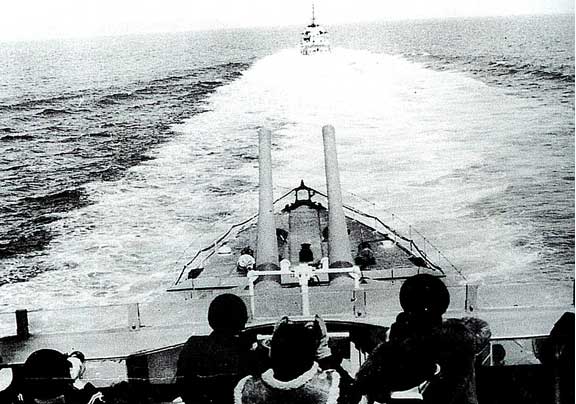 ORP Krakowiak and Kujawiak on convoy protection
ORP Krakowiak and Kujawiak on convoy protection
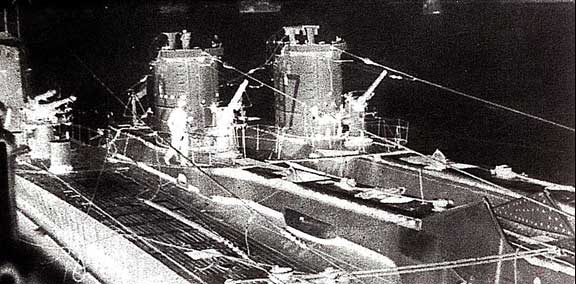 Wilk, SokÛl and Dzik re-supply in the Mediterranean.
Wilk, SokÛl and Dzik re-supply in the Mediterranean.
The Polish Navy was in most major events ranging from support for the Dieppe Raid, invasion of Sicily or D-Day beaches in Normandy. On 6th June 1944 all bar one Polish ship (ORP Garland) was involved in NEPTUNE - the naval part of the operation. The cruiser Dragon was attached to Task Force D in the support of the 3rd Canadian Division at JUNO beach at Courseulles (which later included 1st Polish Armoured Division). The Polish destroyers ORP Slazak and Krakowiak provided cover for the British landings at Ouistreham by protecting the minesweepers and landing craft. Both Blyskawica and Piorun had been attached to the Tenth Destroyer Flotilla, which was made up of the 19th and 20th divisions of which Blyskawica was leader. On the night of the 9th June 1944 the flotilla was off Ushant after the RAF had sighted a large German naval fleet attempting to disrupt the convoys and supply lines to the Normandy beaches. After a decisive battle, the allies crippled the last attempts by the German navy to put to sea again and in which the Polish navy made a significant contribution.
Over 400 men and officers gave their lives for the defence of Britain and Europe from the Nazis.
Polish Mercantile Marine (Polska Marynarka Handlowa, PMH)
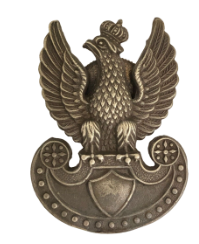
During the inter war years the Polish mercantile fleet had grown to forty ships mainly consisting of bulk cargo carriers for the export of coal and other industrial goods. A cadet force was being trained on ships like the Dar Pomorza and the burgeoning cruise ships. Motor Vessels (MV) Pilsudski, Batory, Sobieski and Chrobry were the pride of the fleet carrying fare-paying passengers on a variety of routes to earn much needed hard currency and acting as a ‘window’ for the modern Polish state. As war loomed, some ships had been adapted and decks strengthened to carry weapons for defence and as part of the strategic plan, should Poland be invaded all ships were to make their way to Britain.
On 28th August 1939 all Polish flag carriers were ordered to remain outside the Baltic Sea and therefore only about 9% of the fleet was lost (Peszke, 1999). Eleven ships were caught in the Baltic Sea, North Sea ports or Danish Straights and sought protection in Sweden where they eventually met in Göteborg before sailing with a Royal Navy escort to Britain via Bergen. SS Śląsk, Rozewie and Poznań were the last to leave the Baltic with SS Rozewie arriving on 18th November 1939 (Peszke, 1999). Dar Pomorza was a sail-training ship bought by Poland and refitted in 1930 and whose voyages included the circum-navigation of the globe. The ship was interned in Stockholm for the duration of the war and eventually became part of the maritime museum in Gdynia.
MV Piłsudski, named after Marshall Józef Piłsudski and built in Monfalcone, Italy, entered service in 1935 for the lucrative north Atlantic run for the Gdynia – Ameryka Linie Zeglugowe transporting emigrants and later refugees. Converted into an armed troopship she sailed out of Newcastle on 26th November 1939 and probably hit a mine off the Humber estuary and sunk before there was a chance to salvage the ship. She was the sister ship of MV Batory, also owned by Gdynia – Ameryka Linie Zeglugowe and sailed under the orders of Britain’s admiralty.
Prior to the war, MV Batory had transported migrants to the USA and as a troopship joined MV Chrobry ferrying troops to Norway for the ill-fated Narvik Campaign (Link: Norwegian Campaign). Between late May and early June 1940, she was in action at Dunkirk, carrying approximately 2,500 people per trip and is reported to have carried as many as 6,000 people in one evacuation and was commanded by Capt. Pacewicz. MV Batory and MV Sobieski formed part of a flotilla to rescue BEF troops and were stationed in Quiberon Bay in the Loire estuary in Operation AERIAL. Again, MV Batory and Sobiesk were sent to Bayonne to pick up refugees and straggling units of the Polish forces (about 6000 troops) who had been misdirected there and embarked them on the 19th June. MV Batory also saw action in the final evacuation of Polish troops from St. Jean de Luz in the south-east of the Bay of Biscay and close to Biarritz (Link: Polish Army). Some 24,246 Polish troops had been evacuated and safely reached Britain.
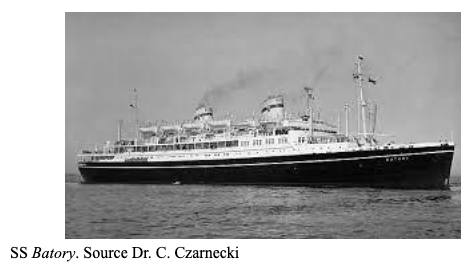
Later, MV Batory was involved in the clandestine operation to transport Britain’s gold reserves and Poland’s national treasures (Operation FISH - about £40m) from Greenock to Montreal in Canada. It was deemed to be the largest transfer of wealth in history (Draper, 1979). Since October 1939, gold was being transferred to the USA for payment and acquisition of arms to support Britain’s war effort. MV Batory was in the second major crossing with the convoy being escorted by HMS Revenge, HMS Bonaventure, and several destroyers. During the crossing Batory had engine trouble and dropped out of the convoy with HMS Bonaventure escorting her to Halifax, Nova Scotia and making running repairs while dodging U-boats and icebergs (Draper, 1979, Swoger, 2004).
On MV Batory’s return, she sailed on 5th August 1940 from Liverpool in convoy WS2 evacuating schoolchildren to Sydney, Australia, and ferrying troops to Singapore during the voyage. Voyages included transporting people to Canada and ferried troops to Oran in operation TORCH (Link: Feluccas & SOE). MV Batory participated in the invasion of Sicily (Operation HUSKY) in July 1943 and southern France in Operation DRAGOON on 15th August 1944, acting as the flagship for General Jean de Lattre de Tassigny, C-in-C of the French Army. Post war and after a re-fit, MV Batory returned to mercantile duties and faced controversial incidents in the USA where ship workers refused to handle the ship’s inventory. The ship continued to work on voyages to the Middle East and East until 1969 and was finally scrapped and broken up in 1971-1972.
MV Sobieski (commanded by Capt. Knoetgen) was also part of the Gdynia – Ameryka Linie Zeglugowe and launched in 1939 prior to the outbreak of war. Sobieski was the sister-ship of MV Batory and was used as a troop ship and assisted in Operation AERIAL for the final evacuation of Polish troops from St. Jean de Luz in the south-east of the Bay of Biscay. Operation AERIAL was post-Dunkirk Evacuation by ‘little ships’ (Operation DYNAMO). AERIAL differed in that it covered a section of coastline covering Brittany and the Bay of Biscay from 16th to 24th June 1940 with operation CYCLE (evacuation of BEF troops from Le Havre) and to recover other stranded BEF forces and the Polish Army in France (Link: Polish Army in France & 2DSP Internment in Switzerland). The port of Dieppe and its navigation channels were blocked to deny the Germans a deep-water and strategic port while Cherbourg, St. Malo, Brest, St. Nazaire and La Pallice harbour in La Rochelle would be used for embarkation and ferried troops to south coast ports in Britain. Some 6,000 Polish soldiers were evacuated from La Pallice during the operation.
Her troopship activities included a voyage in October 1941 from Cape Town, Durban, Lagos, and Freetown with disembarkation in Glasgow (TNA/ BT 26/1192/155). She saw action again in Operation MENACE or the Battle of Dakar in September 1940 where the allies failed to capture the strategic port of Dakar from the Vichy government. Her next major action was in Operation STREAMLINE JANE (Battle of Madagascar) in May 1942 for the invasion of Madagascar which was still Vichy controlled and served as the flagship. The operation was to thwart Japanese ability to seize the island s or ports to secure Allied shipping routes to the Far East and Australia. In the immediate post war, MV Sobieski was used to repatriate British POWs from Japanese camps in Malaya and Thailand. On her return to the mercantile navy, there was a brief period of sailings from Poland to the USA and sold to the Soviet Union in 1950. Her career ended in 1975 when she was scrapped in Italy.
MV Chrobry (commanded by Capt. Deyczakowski) was British built and one of its first duties was to transport the West Nova Scotia Regiment from Halifax, Nova Scotia, Canada to Gourock in Scotland on 21st December 1939. During the Narvik Campaign, she acted as a troop transporter taking British troops from Narvik through Tjeldsundet Straight to the strategic town of Bodø. Attacked at night by dive-bombers, she was hit three times causing a fire and munitions to explode. HMS Wolverine, a W-class destroyer, rescued 700 troops with HMS Stork, a Bittern-class sloop, providing flak cover to protect the stricken ship and enabled remaining survivors to escape and then ferried them to Harsted, on the island of Hinnøya. Aircraft from HMS Ark Royal scuttled the ship which deprived the ground forces of valuable ammunition and stores.
SS Śląsk was built in Denmark in the Nakskov Skibsvaerft A.S. shipyard. in Nakskov as a cargo ship adapted to the Baltic waters and reinforced as an icebreaker. Entering service on 20th January 1931, she operated out of Gdynia for key trade routes between Poland, Finland, and Estonia during the inter-war period (Drozd, 2021). Like many Polish ships, at the outbreak of war, headed to neutral Sweden and berthed at Västervik in Småland, a key port in the region. On 13th November 1939 she sailed for Bergen with SS Poznań (commanded by Capt. Lehr) and arrived in Britain on 18th November 1939. In May 1940 was placed at the disposal of the French Naval Mission and set sail for Kaolack in French West Africa (Senegal) to collect a consignment of peanuts, a key trading and processing port for the nut industry. On the day of the armistice on 22nd June 1940, Polish ships were ordered to vacate French held ports. SS Śląsk was ordered by the British to return to Kaolack, not realising the Vichy Government would impound the ship. There she met her sistership SS Cieszyn and they escaped to the British held port of Bathurst in the Gambia. SS Śląsk until mid-1944 sailed between the USA and Belém in Brazil. In May 1944, she returned to Britain and sailed between Liverpool and Belfast with a British crew. On 11th December 1945, she returned to her home port of Gdynia and remained in service mainly in the Baltic or voyages to Rotterdam and Antwerp until withdrawn from service in June 1967 when scrapped.
SS Cieszyn was also built at Nakskov Skibsvaerft A.S. shipyard in Denmark and adapted to the Baltic waters as an icebreaker and entered service 23rd December 1931. She was regarded as an ‘unlucky ship’ due to various collisions while operating in the Baltic during the inter-war years. At the outbreak of war, she was berthed in Antwerp and escaped to Britain, operating between Britain, France, and Portugal. During its first convoy, collided with SS Harmonic while transporting grain between Britain and France. Repaired in Cherbourg SS Cieszyn was placed under the command of the French Naval Mission and set sail for Kaolack in French West Africa (Senegal) to collect a consignment of peanuts. Escaping with SS Śląsk both ships sailed for the British held port of Bathurst in the Gambia.
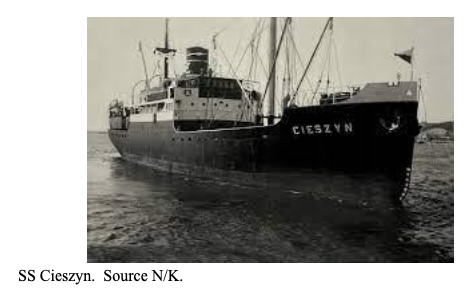
It was planned for SS Cieszyn to be used on a secret mission to transport gold to Dakar, however this plan was aborted when Operation MENACE (23rd September 1940) exposed the plan to British and Free French invasion plans. Having escaped, she plied between British held ports on the west African coast until ordered to return to Britain on 13th January 1941. Her last voyage from Falmouth was a planned rendezvous with a convoy at Glasgow on 20th March 1941. On leaving port, she was attacked by two Dornier bombers and sunk with the crew escaping on lifeboats.
SS Poznań had been originally built in 1913 and requisitioned by the US Navy (Suwanee) in 1920 and then returned to mercantile duties with the Polish American Navigation Corps. Lists of her voyages appears that she did a regular run between Southend to Tyne and Methil in Scotland. These convoys were earmarked FS/ SF in records of her voyages. It is recorded that she was in a collision with a Belgian freighter SS Brabo on 21st March 1942 off South Shields. In operation OVERLORD acted as a transporter to the Mulberry harbour and on 18th June a storm caused a collision with the harbour walls but managed to return to Cardiff for repairs. She survived the war and returned to Poland on 22nd December 1945 then later scrapped in January 1975 after serving as a storage facility in her later years.
SS Rozewie having escaped the Baltic was also placed at the disposal of the French Naval Mission and sent to Dakar and escaped the Vichy Government impounding on 5th July 1940. Her duties were cargo transportation between north and south America. She was torpedoed by a U-boat (U-66) on 6th August 1942 off Trinidad with a loss of three crew with the remaining crew rescued. Capt. Lewandowski was captured by the U-boat and spent the rest of the war in a POW camp.
SS Kordecki, SS Robur III to VII were bulk coal carriers moved to Britain and owned by Związek Kopalń Górnośląskich Robur and entered the war effort having been armed with 12lb pounders and additional machinegun mounts. It is known SS Kordecki was used to load troops and munitions as part of the Normandy campaign in 1944. The fleet also included SS Kmicic (formerly Robur III), SS Częstochowa, SS Zbaraz (formerly Robur VI) and SS Zagloba for convoy duties. SS Kmicic was also used in Operation AERIAL in an action to evacuate Polish and Czech airmen from Bordeaux on 18th June 1940 and sailed to Falmouth in Britain and arrived on 21st June. On board was the Czech fighter ace, Otmar Kučera, one of the ‘Few’ in the Battle of Britain.
SS Zbaraz was bombed in a convoy (FN223) on 15th July 1940 and sunk off the east coast port of Aldeburgh’s lightship. SS Częstochowa was torpedoed on 20th August 1941 in the North Sea by Coastal Torpedo Boat S-48 and SS Zagloba was torpedoed by a U-boat (U-262) and sunk with all crew in a transatlantic convoy (SC 118) in February 1943.
SS Warszawa (commanded by Capt. Ćwikliński until December 1940 and then Capt. Meissner) was a Polish passenger and general cargo ship, built in Britain in Sunderland and entered service in 1914 under the name of SS Smolensk for the Russian Northwest Shipping Co. From 1929, she serviced various routes between Gdańsk, London, Hull, and Cherbourg. During the inter-war period transported refugees and general cargo before running passenger charters to Leningrad, Riga, and Tallinn. By the late 30s was transporting refugees to South America.
At the outbreak of war, SS Warszawa was berthed in La Havre, France and took part in the Dunkirk evacuation. Chartered to supply military equipment to Poland via Romania, the cargo included several crated Morane-Saulnier M.S 406 fighters which were unloaded at Brest. With the fall of France, she was chartered to help evacuate Polish refugees from Greece and Yugoslavia to Marseilles in France, the Lebanon or Palestine (Haifa) helping 5,418 refugees to escape over ten voyages. Temporarily interned by the Vichy Government in Beirut, she escaped to Haifa. Chartered again, she sailed to Mersin in southern Turkey and returned with 3,530 refugees to Palestine in seven voyages. From January 1941 SS Warszawa carried a mixture of food for the 8th Army in Egypt, POWs, and wounded soldiers from Tobruk after she had helped British forces to evacuate from Greece and Crete in April 1941. Sailing in a convoy off Libya (Mersa Matruh), she was torpedoed by a U-boat (U-559) on 26th December 1941 on her way back from Alexandria to Tobruk with 19 passengers and 4 crew killed with 416 troops transferred to HMS Peony (K 40).
SS Narvik (commanded by Capt. Zawada) formerly Empire Runner was British built in Glasgow and operated as a general cargo ship for the Polish Government in Exile. Named Narvik to commemorate the ill-fated Battle of Narvik, it was commissioned in March 1942 with her maiden voyage from Gourock, Scotland to New York. Her return crossing was via Cape Town, Bombay, and Durban. On 10th October 1942 she rescued survivors of SS Orcades that had been torpedoed by U-boat (U-172) and picked up 1,022 survivors. Returning to convoy duties, SS Narvik was also involved in the landing of the Allies in Sicily in July 1943 (Operation HUSKY). She survived the war and returned to Poland in July 1946 and was eventually scrapped in 1967.
SS Chorzów (formally known as Helga) left the port of Bordeaux on 17th June 1940 having delivered coal and tar. She set sail with 193 Polish airmen and some civilians that also included carrying priceless items (the Szczerbiec coronation sword included) from the Polish National treasure (Wawel Treasures) having shipped the treasures from Angers via Libourne. SS Chorzów joined a convey off La Rochelle, which was attacked during the night, forcing Capt. Gora to run for Falmouth at twice the existing speed of the convoy (Swoger, 2004) and reached port on 21st June and berthed the following day on 22nd June after the back-log of convoy ships (97) had been cleared by port authorities. All military staff were bussed off to depots for processing with the civilians’ taken to refugee centres nearby. The curator, Jozef Polkowski guarded the treasure until the ship’s captain returned having sorted out the necessary paperwork for the port authorities and finding food for the crew and any remaining passengers. The shipment was taken by rail to Glasgow via the Polish Embassy in London and placed aboard MV Batory at Greenock as part of Operation FISH with the convoy setting sail on 4th July 1940 (Stone, 2017). SS Chorzów was ordered back to France, and she survived the war after being wrecked off Brazil on submerged rocks in 1953.
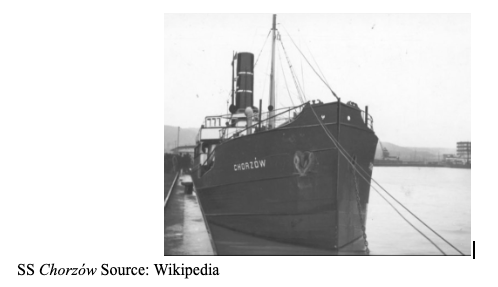
Polish freighters SS Narew, SS Wilno (later changed to Wieluń), SS Katowice (originally named Vendemiare), SS Kraków, SS Chorzow (originally named Helga), SS Toruń and SS Poznań were originally part of the French ‘Chantiers Navals Francais’ in Caen except for SS Chorzów and SS Toruń. These ships assisted delivering troops, munitions, and weapons across the English Channel during Operation 0VERLORD/ NEPTUNE (D-Day). Many of these ships returned to Baltic ports after the war and resumed bulk deliveries of coal to Sweden and Britain as part of the Zegluga Polska and Polskie Marynarce Handlowej lines. SS Katowice was shipwrecked off the Netherlands at Terschelling on 1st March 1949.
Liberty ships were ‘K’ type vessels and loaned to the Polish Government in Exile for $1 and in 1946 operated by Zegluga Polska. These were SS Kutno, SS Kolno, SS Krosno, SS Kowal, SS Kielce (sank in the English Channel in a collision in 1946).
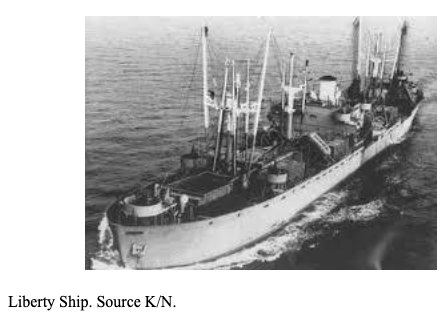
At the outbreak of war, mercantile crews were also scattered across the globe often working on other ships and lines. These personnel trekked across the globe and joined up to continue Poland’s struggle. In many cases their journeys were no less hazardous than those military personnel escaping from Poland and making their way to France or Britain. A training centre was set up in Southampton. The Polish mercantile fleet were found in all theatres of war transporting troops and goods across some of the most hazardous routes throughout the war as part of the Allied Merchant Navy Pool (Peszke, 1999). Many Polish mercantile officers and ratings were awarded both British and Polish medals to honour their bravery during key events during the war.
Selected References:
Bałuk, S.S. (1995) “Poles on the Frontlines of the World War II 1939-1945”, ARS Print Production, Poland.
Draper, A. (1979) “Operation Fish: The race to save Europe’s wealth, 1939-1945”, Cassell, U.K.
Drozd, J. (2021) “Register Files of The State Enterprise and the Joint Stock Company “Żegluga Polska” in Gdynia as a Source in Research on the Polish Merchant Navy under the Second Polish Republic”, Studia Maritima, No. XXXIV, pp. 87-101.
Peszke, M.A. (1999) “Poland’s Navy 1918-1945”, Hippocrene Books Inc, USA.
Stone, D. (2017) “New Light on Old Treasures”, The Polish Review, Vol.62, No.1, pp. 3-18.
Swoger, G. (2004) “The Strange Odyssey of Poland’s National Treasures 1939-1961: A Polish Canadian Story”, Dunurn Press, Canada.
Additional References:
Worsfold, D. (2022) “Operation Aerial: Churchill’s Second Miracle of Deliverance”, Sabrestorm Publishing, UK.
Additional Web Sources:
Link: polish-navy.org
Link: www.ostrycharz.free-online.co.uk/polish_navy.html
Link: www.6juin1944.com
Link: www.bankofcanadamuseum.ca
Link: smp.am.szczecin
Link: nmm.pl
Link: www.polishforcesinbritain.info
Link: www.warsailors.com
Link: www.maritimereviews.co.uk
Link: www.cia.gov
Link: www.convoyweb.org.uk
Link: culture.pl
Link: stefanbatoryoceanliner.weebly.com
|







